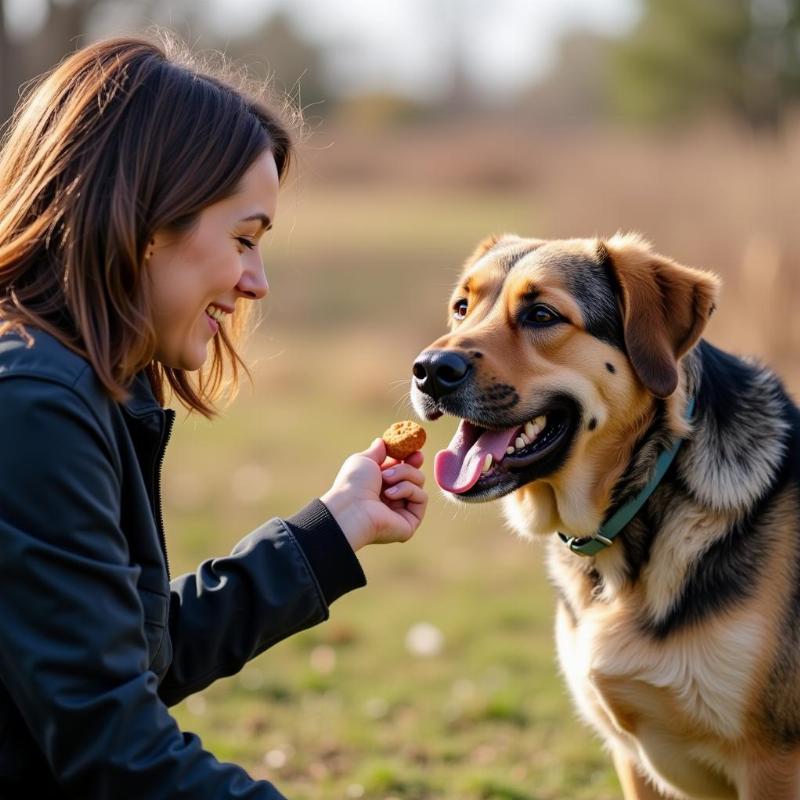Shock collars, also known as e-collars or training collars, are a controversial topic among dog owners, particularly those with large breeds. Understanding their function, proper usage, and potential risks is crucial for responsible pet ownership. This guide aims to provide a comprehensive overview of shock collars for big dogs, focusing on humane training practices and the well-being of your canine companion.
Understanding Shock Collars and Their Impact on Large Breeds
Shock collars deliver a mild electric pulse through contact points on the collar. The intensity can be adjusted, ranging from a slight tickle to a more noticeable stimulation. For big dogs, the effectiveness and safety of shock collars depend heavily on the dog’s temperament, the collar’s quality, and, most importantly, the owner’s understanding of proper usage. Misuse can lead to fear, anxiety, and even aggression.
It’s important to note that using shock collars is not a shortcut to training. They should be used as a tool to reinforce commands already learned through positive reinforcement methods like treats and praise. Never rely solely on a shock collar for training.
Choosing the Right Shock Collar for Your Big Dog
The market is flooded with various shock collar models, making choosing the right one overwhelming. For large breeds, look for collars with adjustable intensity levels, waterproof capabilities, and a long battery life. Consider the dog’s coat thickness; some collars may not be effective through dense fur.
Training Your Big Dog with a Shock Collar: A Humane Approach
The key to using a shock collar effectively and humanely is to start with the lowest setting and gradually increase it only if necessary. The sensation should be enough to get the dog’s attention, not to inflict pain. Always pair the stimulation with a verbal command. The goal is for the dog to associate the command with the sensation, eventually eliminating the need for the collar altogether.
Alternatives to Shock Collars for Big Dog Training
While shock collars can be a training tool, many effective alternatives exist. Positive reinforcement methods like clicker training, reward-based training, and even vibrate-only collars can yield excellent results without the potential risks associated with electric stimulation. Harnesses for extra large dogs can also provide better control and guidance during training sessions.
 Dog Training with Positive Reinforcement
Dog Training with Positive Reinforcement
Addressing Common Concerns About Shock Collars
One of the biggest concerns regarding shock collars is their potential to cause pain and distress. When used correctly, the sensation is more of a surprise than pain. However, misuse can lead to negative consequences. It’s also crucial to consult with a veterinarian or a certified professional dog trainer, especially if your dog has any pre-existing behavioral or medical conditions. They can guide you on the appropriate usage and help you determine if a shock collar is the right choice for your big dog.
Conclusion
Shock collars for big dogs can be a useful training tool when used responsibly and humanely. However, they are not a one-size-fits-all solution and require careful consideration. Prioritize positive reinforcement methods, consult with professionals, and always prioritize your dog’s well-being. Proper training, combined with patience and understanding, will build a stronger bond between you and your canine companion.
FAQ
- Are shock collars cruel for big dogs? When used correctly, a shock collar should not cause pain. Misuse, however, can be detrimental.
- What is the best shock collar for an aggressive large breed? Consult a certified professional dog trainer for personalized recommendations based on your dog’s specific needs.
- Can I use a shock collar on a puppy? Generally, shock collars are not recommended for puppies. Focus on positive reinforcement training.
- Are there any legal restrictions on using shock collars in the US? Regulations vary by state and locality. It’s crucial to check your local laws.
- What are some good alternatives to shock collars? Positive reinforcement training, clicker training, and vibrate-only collars are all excellent alternatives.
Related Articles on Beautdogs.us
- dog shock collar for big dogs
- harnesses for extra large dogs
- collars to prevent dogs from barking
- small dog shock collar with remote
- training shock collar for small dogs
Beautdogs.us is your premier resource for all things dog-related in the US. We offer expert advice on dog breeds, care, training, and product reviews. Whether you’re a first-time dog owner or a seasoned pro, Beautdogs.us is here to help you navigate the world of canine companionship. Contact us at [email protected] or +1 501-555-7529 for any inquiries.